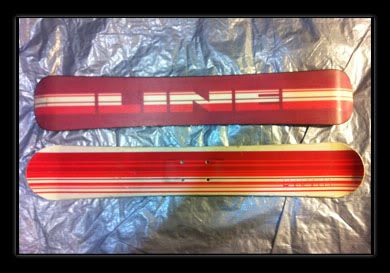In the beginning, there were no rules when it came to skiboard designs. The sport was in its infancy, and manufacturers experimented with many ideas. This was the setting when Jason Levinthal developed and manufactured his first skniboards. They have no specific name, and they are one of the most unique designs that I have ever had the pleasure to ride. The details are as follows:
Dimensions:
Length – 87cm
Width – 16cm
Groomers:
The ’96 Lines are excellent carvers, although their short length means that they tend to get chattery at higher speeds. Edge grip is excellent unless you’re on solid ice, and the side-cut allows for very quick turns. The flex of these boards is definitely on the stiff side, so you get plenty of feedback from the surface you’re riding on. This can make for a very bumpy ride in choppy conditions, but the boards rarely feel out of control.
Park:
The shortness, width, and stiff fles of the ’96 Lines makes them excellent park boards. Although the short length forces you to be very centered on your landings, the stiffness helps to keep you from flexing out if you go backseat. Boxes are a breeze with the 16cm width helping to really lock you on. A slightly wider stance is necessary, but this is easy adapted to.
Powder:
Going simply by the length, you’d image that these boards would be no good in anything deeper than a couple inches of powder. On very shallow inclines, you’d be correct. However, take the Lines down some steep chutes or through some tight steep glades, and you’ll have a totally different experience. Weighting the tails is definitely recommended, but there really isn’t that much a need to concentrate on pulling the tips up as with some other boards. The 16cm width not only provides lots of float, it also gives each board a large frontal area to ride up over snow with. Together these two attributes make the Lines an excellent choice for certain powder conditions.
Bumps:As with most skiboards, the ’96 Lines are easy to maneuver back and forth through moguls. Their width does add one small problem though. In tightly spaced moguls, the boards have a tendency to get a bit tangled against each other. Also, if the moguls are icy you’ll run into issues with grip while trying to navigate through bumps.
Glades:
This is the area where the ’96 Lines really shine in my estimation. At two different mountains, Jay Peak and Mount Bohemia, I felt the let in control and had the most fun when I rode the Lines. The short fat design gives them the perfect blend of agility and float for tackling tight steep powdery glades.
Note on binding inserts:
Back in 1996, a standard had yet to be set for insert patterns on skiboards, so each manufacturer used their own ideas. The Canon Boxters are another good example of this with a binding insert pattern that is rotated 45 degrees from the current standard. In the case of the Lines, the inserts ares spaced much farther apart, approximately 5x6cm square. This was originally meant to allow a proprietary “freeflex” binding, produced by Catek, to be used with the boards. This means that some customization is needed to use current bindings designed for use with skiboards with the now standard 4×4 insert pattern. In my case, I machined special adapter risers to allow Bomber Elite bindings to be used with my boards.
Conclusion:
In my opinion, the 1996 Lines are one of the best designs I’ve ridden in my time on skiboards. Personally, I can’t figure out why JL didn’t continue to produce these boards instead of switching to skinnier designs. Looking at the current trend in skiboard design of boards getting wider, it could be argued that this design was ahead of its time. Whatever the reason was, I wish Line had continued with this model. As it is, these are extremely rare, and I’ve never seen another pair besides mine. If you should happen upon a set, do not hesitate to snatch them up. I find it hard to believe that anyone would not have a blast one these boards.
Rider – Tim – Expert Skiboarder

